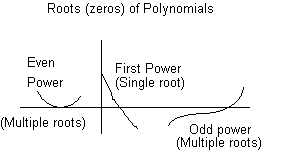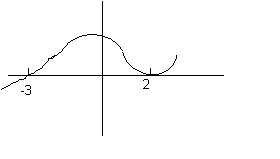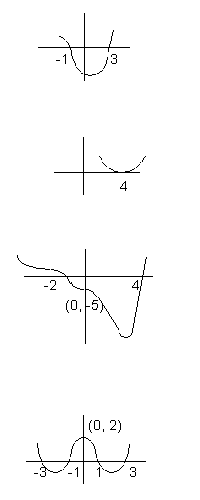Polynomial Functions - Chapter 9
Long-Run Behavior
When we are considering the long-run behavior of a polynomial we are asking what happens to the value of the polynomial when x gets very large in the negative or the positive direction. In general the long-run behavior of a polynomial will be dominated by the term that contains the highest power of x. Let's consider a polynomial of the form f(x)=x3 + x2. This polynomial is of degree 3 (highest power of x) and contains two terms. The table provided below shows the value of each term as x goes from -100 to +100 in steps of various sizes.
| Value of x | Value of x3 Term | Value of x2 Term | Value of Function |
|---|
| -100 | -1000000 | 10000 | -990000 |
| -10 | -1000 | 100 | -900 |
| -5 | -125 | 25 | -100 |
| -0 | 0 | 0 | 0 |
| 5 | 125 | 25 | 150 |
| 10 | 1000 | 100 | 1100 |
| 100 | 1000000 | 10000 | 1010000 |
As you can see from the table as x gets more negative or more positive the x3 term tends to dominate the value of the function. When x is 5 the x3 term is 5/6 of the value of the function. When x is 10 the x3 term is 10/11 of the the value of the function and when x is 100 the x3 term is virtually the whole value of the function (the squared term being much smaller). From this it is clear that for large x the x3 term dominates and represents the long-term behavior of the polynomial. Let's consider a few examples:
- f(x) = 3x5 +27x3 - 16x2 -- The long-run behavior looks like 3x5
- f(x) = -18x3 + 7x2 -- The long-run behavior looks like -18x3
- f(x) = 4x2 - 3x + 9x3 -- In this case the long-run behavior looks like 9x3. The point here is to make sure your function starts with the highest power of x and has the power of x decreasing as you go from left to right.
Short-run Behavior of Polynomials
In addition to appearing in the form shown earlier polynomials can also be shown in factored form. This could look like f(x) = k(x-w)(x+r)(x+u) where k, w, r and u are constants. Each of the terms in brackets is a linear factor of the polynomial. Each of these terms also gives us information about a zero of the polynomial. A zero (also called a root) of a polynomial occurs when a particular value of x causes the total value of f(x) to equal zero. The coordinates of the particular point are (x, 0) and this point is a place where the polynomial touches and may cross, the x axis.Every linear factor of a polynomial represents a zero of the polynomial and conversely, every zero of a polynomial relates to a linear root. If the polynomial has a linear factor at (x-k) then it has a zero at x-k = 0 or x = k. Conversely if a polynomial has a zero at x = -r then (x+r) is a linear factor of the polynomial (since x+r = 0).
In analyzing the short-run behavior of a polynomial it is useful to know that the degree of a polynomial tells us something about its behavior. The graph of an nth degree polynomial will have at most n zeroes and will change directions at most (n-1) times. In other words if the polynomial is of the fourth degree (highest power of x is x4) the polynomial will have no more than 4 x axis crossings and will change directions no more than 4-1=3 times. This should help you graph the function and is also a guide as far as knowing when to stop because you have covered all of the possiblities. Now let's look at short-run behavior.
 If a factor of the polynomial is to a power higher than the first power then it is a repeated root. For example (x-2)2 tells us that there is a double root at x = 2. When we consider single roots and multiple roots there are three cases that will interest us. These are shown in the figure on the right.
If a factor of the polynomial is to a power higher than the first power then it is a repeated root. For example (x-2)2 tells us that there is a double root at x = 2. When we consider single roots and multiple roots there are three cases that will interest us. These are shown in the figure on the right.
The center curve goes straight through the x axis. This is representative of the way a polynomial will behave near a linear factor. The curve to the left approaches the x axis and "bounces", it does not cross the axis. This is characteristic of the behavior of a repeated root where the root is repeated an even number of times (2, 4, ...). The curve on the right "flattens out" as it approaches the x axis. This is characteristic of a repeated root where the root is repeated an odd number of times (3, 5, ...). The three conditions allow us to write the equation of a polynomial by looking at its graph. Consider the figure shown below:
 The simplest equation of the polynomial can be written as f(x) = k(x+3)(x-2)2. To find the value of k we would need information about one point on the curve. Suppose we know that when x = 0 y = 2. Using this information we could write 2=k(0+3)(0-2)2, 2=k(3)(4), k = 2/12, k = -1/6. Now we can write the polynomial as f(x) = 1/6(x+3)(x-2)2.
The simplest equation of the polynomial can be written as f(x) = k(x+3)(x-2)2. To find the value of k we would need information about one point on the curve. Suppose we know that when x = 0 y = 2. Using this information we could write 2=k(0+3)(0-2)2, 2=k(3)(4), k = 2/12, k = -1/6. Now we can write the polynomial as f(x) = 1/6(x+3)(x-2)2.
A similar technique could be used if we are given the zeros and asked to determine a possible function. Assume we have a polynomial that has a single root at x = -5, a single root at x=6, a double root at x=1 and a y intercept of (0,6). The function can be directly written as:
- f(x)=k(x+5)(x-6)(x-1)2
- Using (0, 6) we have f(0) = 6 = k(0+5)(0-6)(0-1)2
- Solving for k gives k = 6/30 = 1/5
- Our final relationship is f(x) = 1/5(x+5)(x-6)(x-1)2
 Let's take another look at all of the cases before we leave this section.
Let's take another look at all of the cases before we leave this section.
In the first case shown there are two roots and they are both single roots.
The equation would be written as f(x) = k(x-[-1])(x-3). f(x)=k(x+1)(x-3). Since we are not given the coordinates of any other point on the curve we cannot determine the value of k.
In the second case depicted the curve only touches the x axis once and bounces (does not go through the axis). This is indicative of multiple root with an even power.
One possible version of the equation would be f(x)=k(x-4)2. As was the case above we don't know any other point on the graph so we can't determine the value of k.
The third case shown has two crossings of the x axis. For the leftmost crossing the curve flattens out before crossing the x axis. This would appear to be a factor that is to some odd power. The rightmost crossing goes straight through the x axis and must represent a linear (first power) root.
We can write one equation of this polynomial as f(x)=k (x + 2)3(x-4). In addition since we also know the point (0, -5) on the graph we can determine the value of k. Substituting the point information we have -5=k(0+2)3(0-4) = k(8)(-4) = -32k. So, k=-5/-32=5/32 and the equation can be written as f(x)=5/32(x+2)3(x-4) (Try it on your calculator to see if the graphs match)
In the last case shown the polynomial has four x axis crossings. The equation is a fourth order polynomial. All of them are crossings that go straight through the x axis (curve doesn't bounce and doesn't flatten out before crossing the axis).
This means that there are four linear factors of the polynomial and we can write the equation as f(x)=k(x+3)(x+1)(x-1)(x-3). Since we know a point on the curve we can find k by using the x and y values of the point: 2=k(0+3)(0+1)(0-3)(0-1)=9k so k=2/9 and the equation is f(x)=2/9(x+3)(x+1)(x-3)(x+1). (Again, try it on your calculator to see if it really works.)
 If a factor of the polynomial is to a power higher than the first power then it is a repeated root. For example (x-2)2 tells us that there is a double root at x = 2. When we consider single roots and multiple roots there are three cases that will interest us. These are shown in the figure on the right.
If a factor of the polynomial is to a power higher than the first power then it is a repeated root. For example (x-2)2 tells us that there is a double root at x = 2. When we consider single roots and multiple roots there are three cases that will interest us. These are shown in the figure on the right.
 The simplest equation of the polynomial can be written as f(x) = k(x+3)(x-2)2. To find the value of k we would need information about one point on the curve. Suppose we know that when x = 0 y = 2. Using this information we could write 2=k(0+3)(0-2)2, 2=k(3)(4), k = 2/12, k = -1/6. Now we can write the polynomial as f(x) = 1/6(x+3)(x-2)2.
The simplest equation of the polynomial can be written as f(x) = k(x+3)(x-2)2. To find the value of k we would need information about one point on the curve. Suppose we know that when x = 0 y = 2. Using this information we could write 2=k(0+3)(0-2)2, 2=k(3)(4), k = 2/12, k = -1/6. Now we can write the polynomial as f(x) = 1/6(x+3)(x-2)2.
 Let's take another look at all of the cases before we leave this section.
Let's take another look at all of the cases before we leave this section.